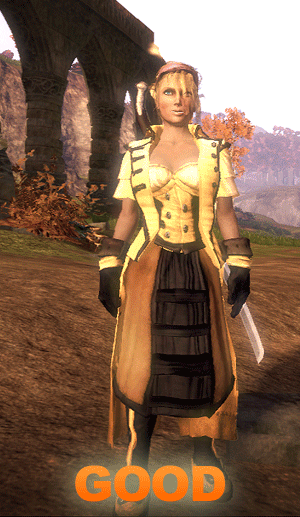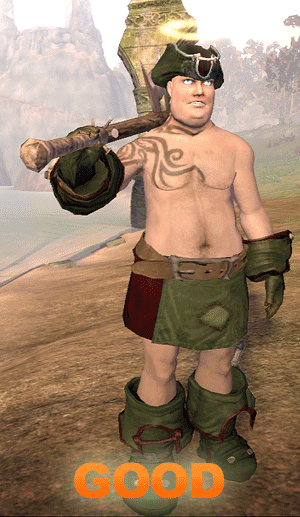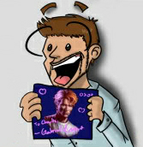Faces of Good and Evil in Fable II
EXCLUSIVE: How to customize your character - and transform you hero - in the world of Albion

Next week, you make a choice. Will you live life as a noble hero or as a dastardly anti-hero? Will you smile at children, offer help to villagers and stay monogamous to your spouse? Or will you scream at children, offer severed trophy heads to villagers and engage in crowded orgies with everyone but your spouse?
Decide carefully, for in Fable II - the sequel to 2004’s fantasy and morality-based RPG - your actions affect everything around you. Your quests and storyline. Your popularity and love life. Your children and pets. And, most importantly, your own appearance.
In this exclusive interview, we chat with John McCormack, art director on Fable II, about how the game determines all of these vast and dramatic transformations. We’ve also got brand new, exclusive artwork to show you just how much is at stake.

GamesRadar: How do you define “good” and “evil” in Fable II?
John McCormack, Art Director on Fable II: We create an environment where the characters and circumstances of the game hold up a moral mirror to the player and ask them what they would do in each situation- not literally, but more in a passive way so that the players feel at ease with their choices and the consequences that come later.
GamesRadar: What kind of choices and behaviors will move you towards one extreme or the other?
JM: Morally, the choices are pretty obvious -do the right thing or not - but the beauty of Fable II lies in the grey areas in between that determine a player’s level of purity in whatever direction they choose to go. The game will pick up on the details of each action and will adjust your character on the fly so that the player isn’t inundated with statistics.
GamesRadar: Is the transformation slow and seamless, or will players notice- or be alerted- at each step of the process?
Sign up to the GamesRadar+ Newsletter
Weekly digests, tales from the communities you love, and more
JM: The player will be alerted to the major moral slides in character so they are never uncertain of what is “right” and what is “wrong." All the other, more subtle, levels of character customization will work in the background. The player will only really notice when one of the villagers points it out by shouting “Hey! Fatty!” Then they’ll take a look at themselves and think, "Oh... I am putting on a bit of weight.” We kind of liked that level of subtlety.

GamesRadar: How did you decide what good and evil looked like? Is evil automatically ugly? Is good automatically beautiful?
JM: This is an area where we took a slightly different approach from the original Fable. We incorporated an extra level of purity-versus-corruption to layer on top of the good-and-evil visual morphs. We found that, when we looked at archetypes of the extremes in character morality, we noticed that there were distinct differences in some areas that could be explained through purity.
For instance, Dracula could be described as “Pure Evil” because, while he is a murderer, he is also quite noble, well mannered and unperverse -this leaves him evil-looking but quite handsome. Whereas a horned, cloven-hooved demon would be a creature of Evil that is also a slave of its desires and has no nobility or manners.We would describe itas “Corrupt Evil,” leaving it ugly, horned and scarred. If you apply this sensibility to both good and evil, you end up with more variation and more control over the hero you will become.
GamesRadar: Does anything transform besides the hero’s basic look? Like his or her voice, clothes, animation, expressions?
JM: The animations change based on alignment but the clothes are dictated by the player and, like the first Fable, the Hero has no voice. We could have made everything associated with the Hero related to the player’s choice in alignment, but we found that this started dictating too much in gameplay and customization terms. Therefore, we deliberately trimmed it all back to just an aesthetic impact - the rest is completely optional for the player.
GamesRadar: How else does your “look” affect gameplay? Can you provide some specific examples of how your hero’s family and the world’s citizens might treat you differently?
JM: If you marry someone and look a certain way, your wife/husband will treat you as they did the first time you met, on the condition you stay that way. If you suddenly come back from a quest with horns, a beer gut and a sex change... well, sometimes love doesn’t always find a way.
GamesRadar: Can your appearance, or the choices that led to that appearance, affect what quests and storylines are available to you?
JM: Definitely. We made an attempt at creating divergent storylines and alignment based quests in Fable, but we never pulled it off as much as we wanted to. Fable II’s world is much more reflective of the hero’s choices and, not only will new quests appear related to the type of hero you are crafting, but entire regions will change over time depending on what you’ve done there.



